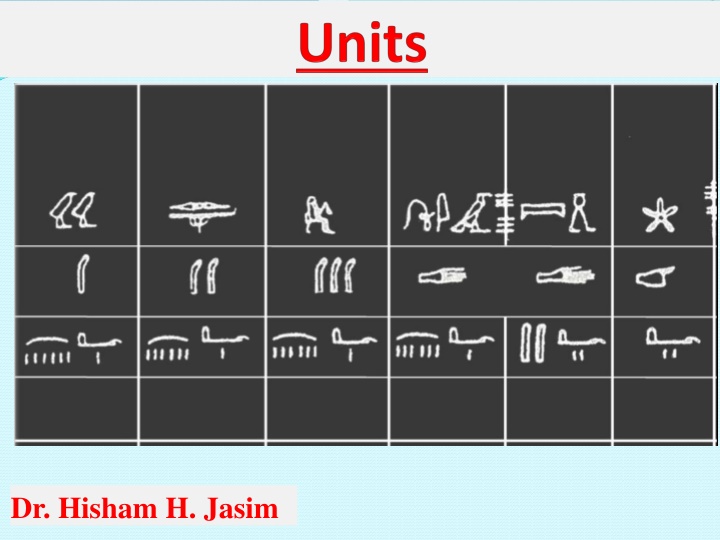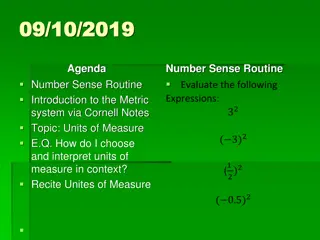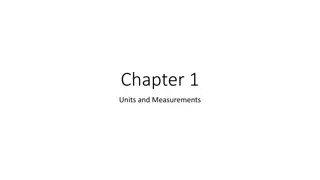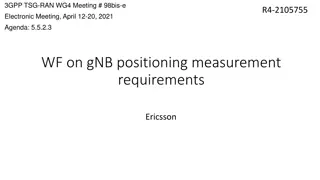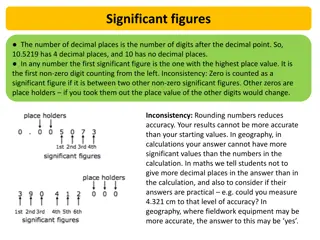Importance of Units in Engineering - Ensuring Accuracy and Clarity
Units of measurement, whether fundamental or derived, play a crucial role in avoiding misinterpretations and errors in engineering. Learn about the significance of internationally accepted, reproducible, and consistent units in accurately measuring physical quantities.
Download Presentation

Please find below an Image/Link to download the presentation.
The content on the website is provided AS IS for your information and personal use only. It may not be sold, licensed, or shared on other websites without obtaining consent from the author.If you encounter any issues during the download, it is possible that the publisher has removed the file from their server.
You are allowed to download the files provided on this website for personal or commercial use, subject to the condition that they are used lawfully. All files are the property of their respective owners.
The content on the website is provided AS IS for your information and personal use only. It may not be sold, licensed, or shared on other websites without obtaining consent from the author.
E N D
Presentation Transcript
Why Are Units of Measurement Important in Engineering? Any type of measurement, such as length and angle, needs both numbers as well as units to avoid misinterpretations. Without themselves have very little meaning. units, the numbers For example, if you were to say that a line's length is 10, one person might assume it as 10 millimeters while the other may think it is 10 meters. But when you add a unit at the end that says "10 meters", there's no scope for uncertainty, thereby reducing the likelihood of errors.
Types of Units Generally we can use any convenient unit to measure a physical quantity depending on how much magnitude we are measuring or in which system of units we want to measure it. What kind of unit we should use? The unit i) must be accepted internationally. ii) Should be reproducible. iii) Should be invariable. iv) Should be easily available. v) Should be consistent. vi) Should be large, if the physical quantity to be measured is a big quantity. vii) Should be small if the physical quantity to be measured is small.
Types of physical Quantities. We can broadly divide the physical quantities into two types i) Fundamental Physical quantities ii) Derived physical quantities. Fundamental physical quantities: A physical quantity which can exist independently is called Fundamental physical quantity. Ex: Length, mass and time etc.
Derived physical quantities: A physical quantity which cannot exist independently is called derived physical quantity. (Or) A physical quantity which is dependent or derived from any other physical quantity is called derived physical quantity. Ex : Area, volume, density, speed, acceleration, force, energy etc.
Like the physical quantities we can divide the units into two types. I)Fundamental units ii)derived units. Fundamental units : The units of fundamental physical quantities are called fundamental units, (or) The units which are independent or can not derive from any other unit is called fundamental unit. Ex: Every unit of length is fundamental unit (irrespective of the system to which it belongs);millimeter, centimeter, meter, kilometer etc. Every unit of time is a fundamental unit. Microsecond, millisecond, second, minute, hour, day etc are units of time. All these units are fundamental units.
Derived units: The units of derived physical quantities are called derived units. Units of area, volume, speed, density, energy etc are derived units. Ex: Every unit of speed is a derived unit ; m/sec, cm/sec, km/hr etc. Every unit of density is a derived unit; kg/m , gr/cm etc. Every unit of acceleration is a derived unit; m/sec , cm/sec , km/hr etc.
System of Units: To measure the fundamental physical quantities Length, Mass and Time we have three systems of units, they are C.G.S system(metric system) F.P.S system (British system) M.K.S system. In all these three systems only three physical quantities mass, length and time are considered to be fundamental quantities.
But, in system International (S.I) system there are seven fundamental physical quantities. Which are i)Mass ii)Length iii) Time iv)Electric current v) Thermo dynamic temperature vi) Luminous intensity vii) Quantity of substance. In addition to the above seven fundamental quantities two more supplementary physical quantities were added. They are i) Plane angle ii)Solid angle
1. C.G.S. Units In this system, the fundamental units of, mass, length, and time are centimeter, gram and second respectively. The C.G.S. units are known as absolute units or physicist's units. 2. F.P.S. Units In this system, the fundamental Units of length, mass and time are foot, pound and second respectively. 3. M.K.S. Units In this system, the fundamental Units of length, mass and time are meter, kilogram and second respectively. The M.K.S. gravitational units or engineer's Units. Units are known as
S.I. Units (International System of Units) The 11th General Conference* of Weights-and Measures have recommended a unified and systematically constituted system of fundamental international use. This system is now being used in many countries. In India, the standards of Weights and Measures Act, 195 (vide which we switched over to M.K.S. units) has been revised to recognize all the S.I. units in industry and commerce. and derived units for
Rules for S.I. Units : The eleventh General Conference of Weights and Measures recommended only the fundamental and derived units for S.I. system. But it did not elaborate the rules for the usage of the units. Later on many scientists and engineers held a number of meetings for the style and usage of S.I. Units. Some of the decisions of the meetings are as follows:
1. For numbers having five or more digits, the digits should be placed in groups of three separated by spaces (instead of commas) counting both to the left and right to the decimal point. 2. In a four digit number, the space is not required unless the four digit number is used in a column of numbers with five more digits. 3. A dash is to be used to separate units that are multiplied together. For example, newton x meter is written as N-m. It should not be confused with mN, which stands for millinewton. 4. Plurals are never used wills symbols. For example, meter or meters are written as m.
5. All symbols are written in small letters except the symbols derived from the proper names. For example, N for newton and W for watt. 6. The units with names of scientists should not start with capital letter when written in full. For example, 90 newton and not 90 Newton
1. Extensive properties. A quantity of matter in a given system Is divided, notionally into a number of parts. The properties of the system, whose value for the entire system is equal to the sum of their values for the individual parts of the system are called extensive properties, e.g. total volume, total mass and total energy of a system are its extensive properties. 2. Intensive properties. It may be noticed that the temperature of the system is not equal to the sum of the temperatures of its individual parts. It is also true for pressure and density of the system. Thus properties like temperature, pressure and density are called intensive properties.
Metrology is the scientific study of measurement.[1]It establishes a common understanding of units, crucial in linking human activities.[2]Modern metrology has its roots in the French Revolution's political motivation to standardize units in France, when a length standard taken from a natural source was proposed. This led to the creation of the decimal- based metric system in 1795, establishing a set of standards for other types of measurements. Several other countries adopted the metric system between 1795 and 1875.
Metrology is divided into three basic overlapping activities:[6][7] The definition of units of measurement The realization of these units of measurement in practice Traceability linking measurements made in practice to the reference standards On 20 May 1875 an international treaty known as the Convention du M tre (Metre Convention)[4]was signed by 17 states
